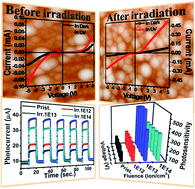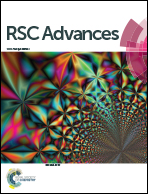Giant UV-sensitivity of ion beam irradiated nanocrystalline CdS thin films
Abstract
A highly sensitive UV-detector is devised for the first time from ion beam irradiated nanocrystalline CdS (nc-CdS) thin films. The UV-sensors are fabricated using pulsed laser deposited nc-CdS thin films on Si wafer and subsequent irradiation treatment. Swift heavy ion irradiation (SHII) of the nc-CdS thin films is carried out using 70 MeV 58Ni6+ ions. The sensors used in the present study are easy to fabricate and require inexpensive materials; they feature characteristics similar to those of UV sensors designed with complex structures and expensive procedures. Current–voltage (I–V) measurements reveal an enrichment in carrier concentration and improvement in conductivity after exposure to SHII. This giant conductivity may be attributed to an enhancement in sulfur vacancies as a consequence of SHII. The sensor exhibits improvements in the responsivity, photosensitivity, and efficiency as a function of the ion fluence and attains maximum values of ∼53 W A−1, 576.4% and 15.6 × 103% respectively for a film irradiated at a fluence of 1 × 1013 ions per cm2. The response time of the sensor reduces with the increase in ion fluence and reaches a minimum of a rise time of 165 ms and fall time of 65 ms at 3 V for these sensors. A possible mechanism involved in the SHII induced moderation of conductivity and consequently photosensitivity is explained on the basis of variation in the defect densities.



 Please wait while we load your content...
Please wait while we load your content...